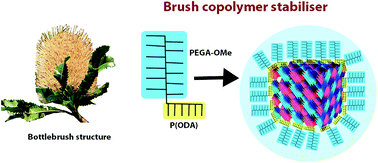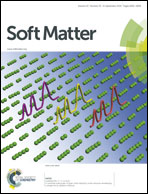Novel RAFT amphiphilic brush copolymer steric stabilisers for cubosomes: poly(octadecyl acrylate)-block-poly(polyethylene glycol methyl ether acrylate)†
Abstract
Copolymers, particularly Pluronics®, are typically used to sterically stabilise colloidal nanostructured particles composed of a lyotropic liquid crystalline bicontinuous cubic phase (cubosomes). There is a need to design and assess new functionalisable stabilisers for these colloidal drug delivery systems. Six amphiphilic brush copolymers, poly(octadecyl acrylate)-block-poly(polyethylene glycol methyl ether acrylate) (P(ODA)-b-P(PEGA-OMe)), synthesised by reversible addition–fragmentation chain transfer (RAFT), were assessed as novel steric stabilisers for cubosomes. It was found that increasing the density of PEG on the nanostructured particle surface by incorporating a PEG brush design (i.e., brush copolymer), provided comparable and/or increased stabilisation effectiveness compared to a linear PEG structure, Pluronic® F127, which is extensively used for steric stabilisation of cubosomes. Assessment was conducted both prior to and following the removal of the dodecyl trithiocarbonate end-group, by free radical-induced reduction. The reduced (P(ODA)-b-P(PEGA-OMe) copolymers were more effective steric stabilisers for phytantriol and monoolein colloidal particle dispersions than their non-reduced analogues. High throughput characterisation methodologies, including an accelerated stability assay (ASA) and synchrotron small angle X-ray scattering (SAXS), were implemented in this study for the rapid assessment of steric stabiliser effectiveness and lyotropic liquid crystalline phase identification. Phytantriol cubosomes stabilised with P(ODA)-b-P(PEGA-OMe) copolymers exhibited a double diamond cubic phase (QD2), whilst monoolein cubosomes exhibited a primitive cubic phase (QP2), analogous to those formed using Pluronic® F127.


 Please wait while we load your content...
Please wait while we load your content...